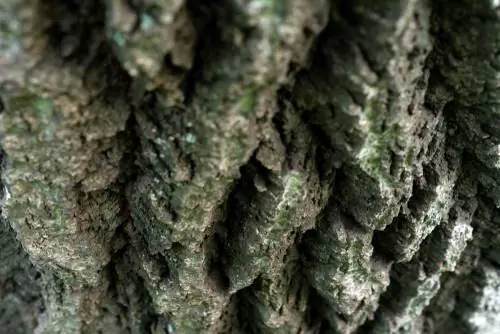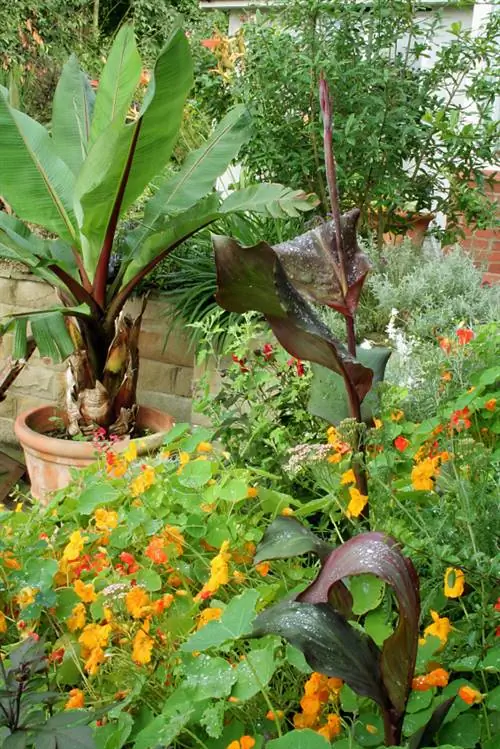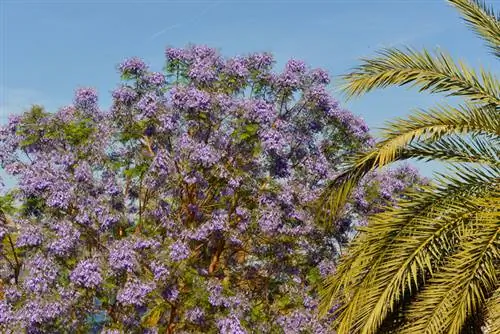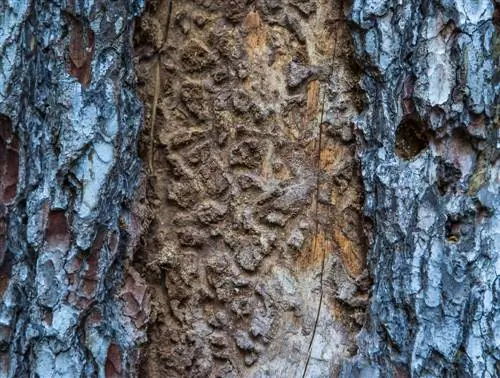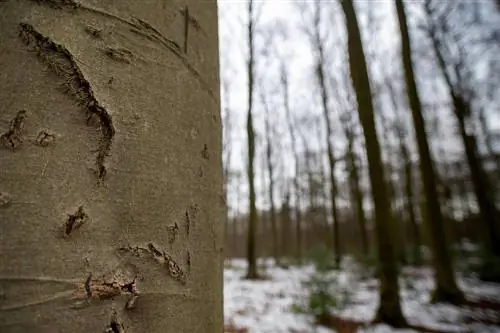- Author admin [email protected].
- Public 2023-12-16 16:46.
- Last modified 2025-01-23 11:22.
The bark of a tree is not just a structured structure on the trunk. It is an important organ that performs vital functions. Even a small piece of tree bark shows how the tree protects itself against environmental influences.
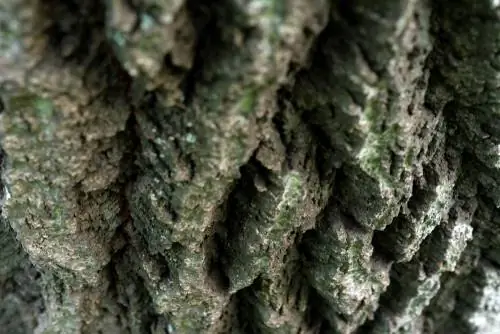
What is tree bark for and how does it help with tree species identification?
Tree bark is an important organ that protects trees from environmental influences such as frost and fire. It consists of bast and bark, whereby the bast is responsible for the transport of sugar compounds and the bark serves as a natural barrier. Bark can help identify tree species through its structure, color and pattern.
Trees and their bark
Woods serve as privacy screens or as fruit suppliers in the garden. In most cases the bark is not a selection criterion. But many trees are characterized by aesthetic bark that sets visual accents in every season. It's not just the structure of this natural protective cover that varies from smooth to silky to rough and wrinkled. The coloring can also take on all shades from red to brown to green.
| Species | Colorings | Pattern variety | |
|---|---|---|---|
| Maple | Striped maple, coral bark maple, rusty beard maple, snakeskin maple | coral red, orange, golden yellow, olive green | Chocolate shavings, cinnamon rolls, snake skin |
| Birch | Black birch, Himalayan birch, silver birch, downy birch | snow-white, yellow-white, reddish, black-brown | Bark comes off in wide strips |
| Beech | Blood beech, stone beech, weeping beech, Süntel beech | dark green, black, silver gray | pitted, cracked, smooth |
| Oak | Swamp Oak, Downy Oak, Cereal Oak | reddish, gray, greenish | fielded, furrowed, scaly |
| Pine | Scots pine, black pine | red brown, gray brown, dark | scaly, furrowed |
| Ash | Common Ash | light green, gray, black | smooth, cracked, ribbed |
Different trees have such different barks, that always fascinates me tree trees bark treebark surface texture treebark bark autumn treeoninstagram volksgartenletmathe treesimherbst treesoninstagram
A post shared by Anne (@anneskleingarten) on Sep 26, 2019 at 5:28am PDT
Functions of the bark
The outer layers, collectively referred to as bark, are called bast and bark. The bast serves to transport sugar compounds through the tree, while the bark takes on a protective function. It is the natural barrier against environmental influences such as frost and fire. Extreme temperatures are buffered by air pockets in the bark. Since the bark cells have died, they hardly need any energy.
Functions of the bark:
- Protection Wall
- Growth Zone
- Information Center
- Communication Organ
Excursus
Stem building
An important difference between woody and herbaceous plants is the trunk of a tree, which cannot only grow upwards. Over the years he gets fatter. The cambium is responsible for this so-called thickness growth. It forms bast cells that grow outwards. Additionally, this layer produces wood cells inwards. It is only a few cells thick and cannot renew itself even if damaged. Inside is the pith, which is surrounded by the heartwood and sapwood.
Determine tree bark
Identifying trees by their bark takes a lot of practice. Species such as birch, plane tree and beech have an unmistakable bark. Other species are very similar in color and structure, so that additional identifying characteristics often have to be used. Growth habit and habitat play a large role in identification. You can also look at dried leaves directly under the tree as this provides clear information about the species.
Protect and repair bark
If the bark has been damaged, the tree must quickly close these wounds. The cambium also takes on this task. It forms the so-called wound wood, which pushes itself over the wound and closes it. Since this process takes several months to years, the tree must resort to initial relief measures.
Emergency measure
In some trees, resin comes out of the wound, which closes it. Other types seal off the wood pores from the outside so that no fungi or pathogens can penetrate. If the cambium is injured, it will no longer be formed again. At this point the sap lines are interrupted and the tree has to compensate for this loss. It is therefore even more important that the bark of a tree is protected and not damaged.
Anyone who peels the bark off a living tree damages it.
Why the bark cracks
Cracks on trees can be traced back to different causes. Not only mechanical damage but also insect and fungal infestation cause cracks to form. Damage to the cherry tree bark is often caused by strong temperature fluctuations between day and night. At night, the north side of the trunk cools down faster than the southern side of the trunk, which is still warm from the day. The resulting tension causes the bark surface to tear.
Heal bark
The tree will seal large cracks in the bark over the years by growing over them. The most important measure is good care. Make sure that the tree is optimally supplied with water and nutrients. Active measures to close the wound always turn out to be negative.
You should avoid this:
- Wound closure products ensure a fungus-friendly environment
- Cutting off the edge of the wound leads to loss of vitality
- Covering with black foil worsens the microclimate
Bark problems
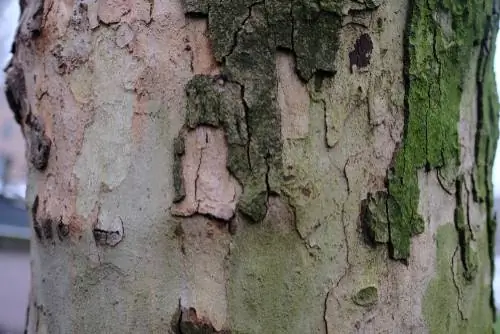
In most cases, there is no need to worry if the tree loses its bark
If the bark cracks and falls off, it's nothing to worry about. However, larger injuries should be investigated. Cracks can occur due to environmental influences or mechanical means.
Damage to fibrous bark
Squirrels occasionally collect fibrous, peeling bark from certain conifers to use as upholstery material. They pull the fibers of the bark from living trees and work in a flat and vertically oriented manner. The worked areas are usually in the lower trunk area. Here the bark appears fibrous-rough to bristly.
Affected trees are exotic:
- Giant Sequoia
- Japanese sickle fir
- Giant Tree of Life
- Chinese Redwood
- Bald Cypress
Tree bark eroded, injured or damaged
Young trees are more often affected by bark damage than old trees. However, age is not a complete exclusion criterion, as trees in the forest are more often eaten by wild animals or otherwise damaged. If the feeding damage only occurs at certain points and the trunk has not been stripped of bark all around, you can disinfect the wound with nettle manure. Provide the tree with water and nutrients so it can regenerate itself.
Bark completely peeled away
Fallow deer prefer young fruit trees and sometimes eat the entire bark of the lower trunk area. If there is severe damage, the pathways are severed and the tree can no longer supply itself with nutrients. If there are some cable channels, you can seal the open areas with clay. If the conductive pathways are completely destroyed, you can try to create juice pathways.
Create a juice bridge as an emergency rescue:
- cut off a sufficiently strong branch
- bevel on both sides
- Push above and below the ringing under the bark of the trunk
- unwind with raffia
Common diseases
There are some diseases that cause bark injury in early or later stages. The symptoms are disease-specific. Groove-shaped cracks can appear that go deep into the wood. Cracked sores in the bark can be accompanied by scab formation. The diseases cause other typical symptoms such as wood discoloration or changes in the crown area.
- Bark burn: Stone fruit is affected in permanently wet weather
- Bark scab: affects rose plants damaged by drought and stress
- Sooty bark disease: occurs in maple trees that are stressed by drought

Bark burn is not easy to detect
Treat fungal infestation
What is almost normal in old trees can also occur in young trees: chipped bark caused by fungi. While with white rot the wood appears fibrous and is covered by a white-gray veil, with brown rot dark brown to black discoloration occurs. The wood beneath the bark crumbles into cubes. 30 different types of fungi are responsible for these symptoms. They settle in open wounds where there is a moist microclimate.
First aid:
- cut out small wounds into he althy wood
- disinfect with nettle manure
- Provide the tree with water and nutrients
Pests?
There are some beetles that can settle under the bark and create impressive tunnel systems. But not all species living under the bark are dangerous for the tree. The type of passages can provide an indication of the species that lives in the wood.
| Symptoms | Pest | ||
|---|---|---|---|
| bark beetle | Feeding passages between bark and wood with typical central passage | yes | |
| Pride beetle | Zig-zag feeding passages between bark and wood | no | |
| ant | Gallery systems and chambers in dead heartwood | no |
Use and process bark
Do not remove the bark without good reason to avoid causing unnecessary stress to the tree. Tree bark is ideal for crafting and processing. To do this, collect bark from dead branches that you find in the forest. You can peel the trunk with a drawknife or carve squares into the bark with a knife and then peel them off.

Preserve
The best method for preserving bark is extensive drying. When the pieces are heated, no microorganisms survive. Mold does not grow on dry wood, so further treatment with wood preservatives is unnecessary. Always keep an eye on the material when drying in the oven to avoid possible charring.
How to proceed:
- Place the wood on a tray covered with baking paper
- bake at 100 degrees for 30 minutes
- then let it cool down
Tip
You can alternatively let the bark pieces dry in a sauna or microwave. Bark also dries well with a hairdryer or on the heater.
DIY ideas
If you don't want to buy decorations, you can collect tree bark and use it in a variety of crafts and decorations. Pieces of bark are grateful objects because they do not require any elaborate preparation. They can be used to make arrangements or natural flower bowls. You can also use the bark pieces to beautify furnishings.
Planting bark
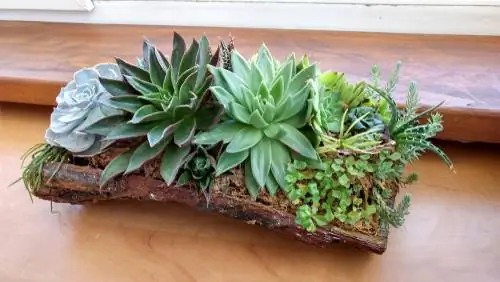
Barks make beautiful plant bowls
Large pieces of bark that you can find in the forest after tree felling are ideal objects for planting. Choose species that grow in gravelly and sandy soil and have low water requirements. This means the bark doesn't get too wet and lasts longer. Succulents or tillandsias feel particularly comfortable in the bark bowl.
The mini garden:
- Substrate: Mixture of gravel, gravel and sand
- Plants: houseleek, Jupiter's beard, stonecrop
- Decoration: bizarre stones, mini tin watering can
Tip
Glue blown eggs and moss to the tree bark and convert the eggs into a mini flower vase. This gives you an individual Easter decoration.
Summer decoration: bark pot
The texture of the tree bark creates a natural atmosphere that goes perfectly with houseplants, culinary herbs or small shrubs. With just a few resources you can make a summer flower pot out of bark. Birch bark works well and provides color contrasts.
How to do it:
- Place bark around the desired flower pot
- Cut a piece of bark and cover it with hot glue
- press onto the pot and secure with clothespins
Autumn decoration: arrangement
A large piece of bark provides the basis for a rustic table decoration. Collect moss, leaves, acorns and rose hips to decorate. Place pillar candles on the tray and distribute the natural materials on them. Tree mushrooms complete the arrangement. These can be easily dried and last forever.
Christmas decorations: Christmas tree
For the Christmas tree you will need several pieces of bark of different sizes. Poke a hole in the center of each piece of bark. These are placed on a shish kebab skewer in decreasing size, so that a Christmas tree-shaped shape is created. To make the tree stand, the shish kebab skewer is inserted into a tree disc. You can crown your Christmas tree with a self-cut birch bark star.
More natural decorations for Christmas:
- Christmas tree decorations made of star-shaped pieces of bark
- Advent arrangements with red candles, fir branches and bark figures
- wooden heart covered with moss
Frequently asked questions
Why does the bark of trees peel off?
The fact that trees shed their bark has nothing to do with drought. After a rainy spring, there is often a growth spurt and the trees lose their bark. The bark consists of dead cells that are renewed by the bast. The bark grows as the tree increases in thickness. The bark splits open because the tension becomes too great. This bark shedding is particularly noticeable on plane trees.
Should I remove growths on the bark?
On the side of the trunk that faces the weather, there is often growth of lichens and mosses. However, such natural layers do not harm the tree. They provide additional protection from the elements and should therefore not be removed. If you remove lichens and mosses with a brush, you damage the bark and fungi can penetrate the wounds.
Why do green mushrooms grow on the bark?
Excessive lichen growth on individual branches indicates that they are slowly dying. There are different species of lichen, the color of which can vary from yellow to orange to green and gray. The common yellow lichen often occurs on tree bark and is called a yellow or green fungus because of its color. Instead of removing the growth, you should cut off the affected branches at the base. This allows the tree to invest its energy in developing fresh branches.
Can you eat tree bark?
Tree bark itself is not edible because it is neither easy to digest nor nutrient-rich. Bread with added bark has a long tradition in Northern Europe. To counteract starvation, the flour was thickened with ground pine bark. Today, bark bread is a luxury item. To make it, the white bast layer is scraped off, dried and ground. Edible bark spaghetti is made in a similar way.
Products with tree bark:
- Tea made from the bark of the Lapacho tree
- Cinnamon as a spice made from tree bark

